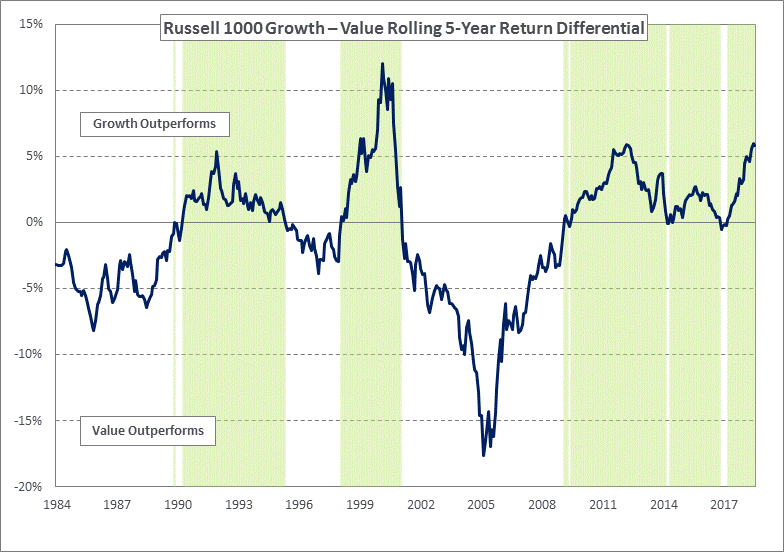Ten years ago, the global financial crisis upended capital markets as we knew them. It also disrupted some longstanding traditions in the investing world. One such casualty: the reign of value stocks over growth equities1.
Historically, value investing outperformed growth equities, as investors tend to bid up fast-growing, exciting companies—like those in the technology sector—while overlooking the stodgier but stable firms and dismissing temporarily troubled ones. But much to the frustration of investors, for the past decade, value stocks have been languishing in the shadow of growth equities, which have soared.
Last month was no different. In August, the Russell 1000 Growth Index gained 5.5% compared to returns of 1.5% for the Russell 1000 Value Index, bringing the differential between the two indexes to 17.7% on a one-year basis, and an annualized 3.8% over a 10-year period. The Russell 1000 Growth is trading at a price-to-earnings multiple of 28.4, with five-year earnings growth of 14.6%, compared to 16.2 for the Russell 1000 Value and 4.7% earnings growth during the same period. The dominance of growth stocks over value investing is not limited to just the United States. In emerging markets, the MSCI Emerging Markets Growth Index is trading at a P/E ratio of 19.6 compared to 10.6 for the MSCI Emerging Markets Value Index.
At NEPC, we understand that these years of underperformance—particularly during a period of robust economic expansion—are a challenge for investors. Maintaining discipline through cycles is difficult but we believe it would be a mistake to write off value stocks. After all, we’ve been here before: The booming economy and exuberance over technology companies in the 1990s led to growth besting value for most of that decade. Investors wondered if value would ever stage a comeback, only to have value soundly beat growth for eight straight years on the back of the bust of the dot-com bubble.
The subsequent dethroning of value dates back to the financial crisis. It may be hard to believe today, but technology stocks took a pummeling in 2008. At the time, the S&P 500 technology sector shed 42.1% of its value compared to a 37.0% loss for the S&P 500. While growth stocks are typically pricier than value equities, they traded at lower multiples in early 2009. Meanwhile, financials—a staple of value investors—came under fire for the role they played during the crisis, triggering a flurry of restrictions from regulators; this curtailed their risk-taking, thus dampening future profitability. The stage for outperformance of growth over value had been set.
Giving growth equities an added edge was the market domination of a handful of tech giants. Apple, Amazon, Facebook, Microsoft and Google were 2.8% of the S&P 500 in 2007; they now make up 16.6% of the benchmark. Amazon, the 109th largest company in the S&P 500 at the time, now occupies third place; Facebook, which didn’t go public until May 2012, currently carries the fourth largest weighting in the index. On the other hand, a sharp, sustained drop in prices of energy and materials—also portfolio favorites of value investors—towards the end of 2015 further pulled down value stocks.
Meanwhile, the MSCI EM Index, a benchmark for emerging market equities, is heavily weighted towards Asia and includes tech stocks Tencent and Alibaba, which carry the first and fourth largest weightings. This is in stark contrast to 2007, when these two tech stocks weren’t even in the index; at the time, the index was dominated by petroleum giant PetroBras and metals and mining behemoth Vale, both Brazilian state entities, with China Mobile serving as the largest Chinese stock. (The changes have been less pronounced in non-US developed markets where technology holds a smaller weighting and large, new market participants haven’t entered the benchmark.)
That said, slowing growth within the technology sector, with a resurgence in energy, financials and materials could shift the balance of power. In any event, we encourage our clients to not give up on value stocks. We believe the outsized performance of growth may be an appropriate funding source to rebalance and redeploy to non-US equities and safe-haven fixed income, which is in line with our overall recommendation to trim gains from US equities. At the very least, we believe it is appropriate to reposition within equities to ensure balance between value and growth.
In addition, for all equity holdings, we suggest not isolating the sole underperformers, but looking at the total equity allocation, or US/international/emerging markets allocations holistically. This exercise could lead to complementing value with growth exposure, maybe in small caps, or through a broader mandate. Or adding complementary exposure to global, international, private equity or global asset allocations. And ensuring the presence of a suitable benchmark for the manager in question to evaluate over- and under-performance.
For the emerging markets component, if your sole exposure is through a value manager, we suggest considering supplementing that mandate with additional emerging markets exposure. This could be through a dedicated emerging markets small-cap strategy, another emerging markets all-cap mandate or even introducing a Global or ACWI ex-US manager to your allocation. For clients with a higher tolerance for private assets, this could even be achieved through dedicated private equity investments in Asia.
We continue to actively watch this space and are closely following this trend. Please reach out to us if you have questions on your portfolio or would like to further this discussion.
1 For the sake of this discussion, when talking about growth, we are referring to companies with both higher historical revenue or earnings growth and higher estimated earnings and revenue growth. Value companies, conversely, tend to trade at lower price-to-earnings or price-to-book multiples.




